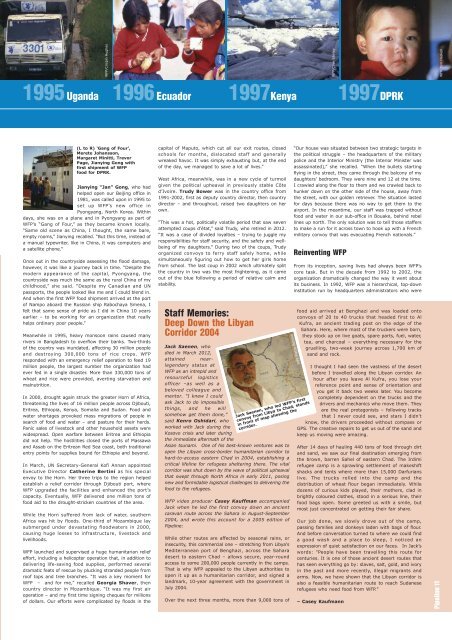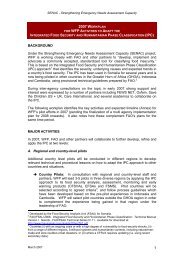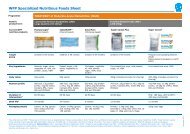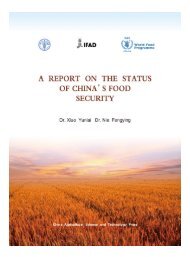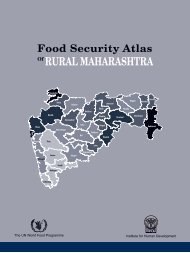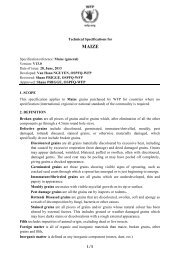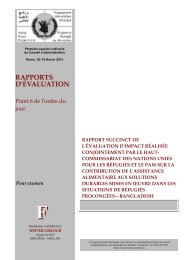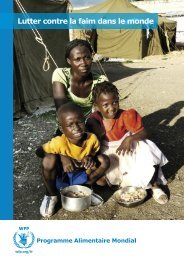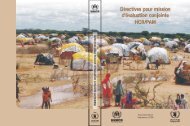Pipeline 50 Years - WFP Remote Access Secure Services
Pipeline 50 Years - WFP Remote Access Secure Services
Pipeline 50 Years - WFP Remote Access Secure Services
- No tags were found...
You also want an ePaper? Increase the reach of your titles
YUMPU automatically turns print PDFs into web optimized ePapers that Google loves.
<strong>WFP</strong>/Crispin Hughes<strong>WFP</strong>/R. Jones<strong>WFP</strong>/Clive Shirley<strong>WFP</strong>/Tom Haskell1995 1996 Uganda Ecuador 1997Kenya 1997DPRK(L to R) ‘Gang of Four’,Merete Johansson,Margaret Minitti, TrevorPage, Jianying Gong withfirst shipment of <strong>WFP</strong>food for DPRK.Jianying “Jan” Gong, who hadhelped open our Beijing office in1981, was called upon in 1995 toset up <strong>WFP</strong>’s new office inPyongyang, North Korea. Withindays, she was on a plane and in Pyongyang as part of<strong>WFP</strong>’s “Gang of Four,” as they became known locally.“Same old scene as China, I thought, the same bare,empty rooms,” Jianying recalled. “But this time, instead ofa manual typewriter, like in China, it was computers anda satellite phone.”Once out in the countryside assessing the flood damage,however, it was like a journey back in time. “Despite themodern appearance of the capital, Pyongyang, thecountryside was much the same as the rural China of mychildhood,” she said. “Despite my Canadian and UNpassports, the people looked like me and I could blend in.And when the first <strong>WFP</strong> food shipment arrived at the portof Nampo aboard the Russian ship Rabochaya Smena, Ifelt that same sense of pride as I did in China 10 yearsearlier – to be working for an organization that reallyhelps ordinary poor people.”Meanwhile in 1995, heavy monsoon rains caused manyrivers in Bangladesh to overflow their banks. Two-thirdsof the country was inundated, affecting 30 million peopleand destroying 300,000 tons of rice crops. <strong>WFP</strong>responded with an emergency relief operation to feed 19million people, the largest number the organization hadever fed in a single disaster. More than 330,000 tons ofwheat and rice were provided, averting starvation andmalnutrition.In 2000, drought again struck the greater Horn of Africa,threatening the lives of 16 million people across Djibouti,Eritrea, Ethiopia, Kenya, Somalia and Sudan. Food andwater shortages provoked mass migrations of people insearch of food and water – and pasture for their herds.Panic sales of livestock and other household assets werewidespread. Open warfare between Eritrea and Ethiopiadid not help. The hostilities closed the ports of Massawaand Assab on the Eritrean Red Sea coast, both traditionalentry points for supplies bound for Ethiopia and beyond.In March, UN Secretary-General Kofi Annan appointedExecutive Director Catherine Bertini as his specialenvoy to the Horn. Her three trips to the region helpedestablish a relief corridor through Djibouti port, where<strong>WFP</strong> upgraded the facilities and enhanced the port’scapacity. Eventually, <strong>WFP</strong> delivered one million tons offood aid to the drought-stricken countries of the area.While the Horn suffered from lack of water, southernAfrica was hit by floods. One-third of Mozambique laysubmerged under devastating floodwaters in 2000,causing huge losses to infrastructure, livestock andlivelihoods.<strong>WFP</strong> launched and supervised a huge humanitarian reliefeffort, including a helicopter operation that, in addition todelivering life-saving food supplies, performed severaldramatic feats of rescue by plucking stranded people fromroof tops and tree branches. “It was a key moment for<strong>WFP</strong> – and for me,” recalled Georgia Shaver, thencountry director in Mozambique. “It was my first airoperation – and my first time signing cheques for millionsof dollars. Our efforts were complicated by floods in thecapital of Maputo, which cut all our exit routes, closedschools for months, dislocated staff and generallywreaked havoc. It was simply exhausting but, at the endof the day, we managed to save a lot of lives.”West Africa, meanwhile, was in a new cycle of turmoilgiven the political upheaval in previously stable Côted’Ivoire. Trudy Bower was in the country office from1991-2002, first as deputy country director, then countrydirector – and throughout, raised two daughters on herown.“This was a hot, politically volatile period that saw sevenattempted coups d’état,” said Trudy, who retired in 2012.“It was a case of divided loyalties – trying to juggle myresponsibilities for staff security, and the safety and wellbeingof my daughters.” During two of the coups, Trudyorganized convoys to ferry staff safely home, whilesimultaneously figuring out how to get her girls homefrom school. The last coup in 2002 which ultimately splitthe country in two was the most frightening, as it cameout of the blue following a period of relative calm andstability.Staff Memories:Deep Down the LibyanCorridor 2004Jack Saenen, whodied in March 2012,attained nearlegendarystatus at<strong>WFP</strong> as an intrepid andresourceful logisticsofficer –as well as abeloved colleague andmentor. “I knew I couldask Jack to do impossiblethings, and he willsomehow get them done,”said Kenro Oshidari, whoworked with Jack during theKosovo crisis and later duringthe immediate aftermath of theAsian tsunami. One of his best-known ventures was toopen the Libyan cross-border humanitarian corridor tohard-to-access eastern Chad in 2004, establishing acritical lifeline for refugees sheltering there. The vitalcorridor was shut down by the wave of political upheavalthat swept through North Africa in early 2011, posingnew and formidable logistical challenges to delivering thefood to the refugees.<strong>WFP</strong> video producer Casey Kauffman accompaniedJack when he led the first convoy down an ancientcaravan route across the Sahara in August-September2004, and wrote this account for a 2005 edition of<strong>Pipeline</strong>:While other routes are affected by seasonal rains, orinsecurity, this commercial one – stretching from Libya'sMediterranean port of Benghazi, across the Saharadesert to eastern Chad – allows secure, year-roundaccess to some 200,000 people currently in the camps.That is why <strong>WFP</strong> appealed to the Libyan authorities toopen it up as a humanitarian corridor, and signed alandmark, 10-year agreement with the government inJuly 2004.Over the next three months, more than 9,000 tons of<strong>WFP</strong>/Pietro BertoraJack Saenen, who led <strong>WFP</strong>’s firstconvoy from Libya to Chad, standsin front of map showing thecorridor.“Our house was situated between two strategic targets inthe political struggle – the headquarters of the militarypolice and the Interior Ministry (the Interior Minister wasassassinated),” she recalled. “When the bullets startingflying in the street, they came through the balcony of mydaughters’ bedroom. They were nine and 12 at the time.I crawled along the floor to them and we crawled back tohunker down on the other side of the house, away fromthe street, with our golden retriever. The situation lastedfor days because there was no way to get them to theairport. In the meantime, our staff was trapped withoutfood and water in our sub-office in Bouake, behind rebellines up north. The only solution was to tell those staffersto make a run for it across town to hook up with a Frenchmilitary convoy that was evacuating French nationals.”Reinventing <strong>WFP</strong>From its inception, saving lives had always been <strong>WFP</strong>’score task. But in the decade from 1992 to 2002, theorganization dramatically changed the way it went aboutits business. In 1992, <strong>WFP</strong> was a hierarchical, top-downinstitution run by headquarters administrators who werefood aid arrived at Benghazi and was loaded ontoconvoys of 20 to 40 trucks that headed first to AlKufra, an ancient trading post on the edge of theSahara. Here, where most of the truckers were born,they stock up on live goats, spare parts, fuel, water,tea, and charcoal – everything necessary for thegruelling, two-week journey across 1,700 km ofsand and rock.I thought I had seen the vastness of the desertbefore I travelled along the Libyan corridor. Anhour after you leave Al Kufra, you lose yourreference point and sense of orientation andyou get it back two weeks later. You becomecompletely dependent on the trucks and thedrivers and mechanics who move them. Theyare the real protagonists – following tracksthat I never could see, and stars I didn'tknow, the drivers proceeded without compass orGPS. The creative repairs to get us out of the sand andkeep us moving were amazing.After 14 days of hauling 440 tons of food through dirtand sand, we saw our final destination emerging fromthe brown, barren Sahel of eastern Chad. The Irdimirefugee camp is a sprawling settlement of makeshiftshacks and tents where more than 15,000 Darfurianslive. The trucks rolled into the camp and thedistribution of wheat flour began immediately. Whiledozens of curious kids played, their mothers, clad inbrightly coloured clothes, stood in a serious line, theirfood bags open. Some greeted us with a smile, butmost just concentrated on getting their fair share.Our job done, we slowly drove out of the camp,passing families and donkeys laden with bags of flour.And before conversation turned to where we could finda good wash and a place to sleep, I noticed anexpression of quiet satisfaction on our faces. In Jack’swords: "People have been travelling this route forcenturies. It is one of those ancient desert routes thathas seen everything go by: slaves, salt, gold, and ivoryin the past and more recently, illegal migrants andarms. Now, we have shown that the Libyan corridor isalso a feasible humanitarian route to reach Sudaneserefugees who need food from <strong>WFP</strong>."– Casey Kaufmann<strong>Pipeline</strong> 11


